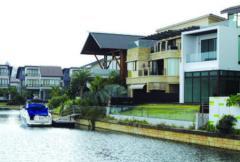
Developers required to build better flood systems
0.2-hectare and larger projects need to comply.
In a release, the government's water agency, PUB, said that revisions have been made to the Code of Practice on Surface Water Drainage as part of its holistic stormwater management strategy for Singapore.
The changes include a new requirement for developers to implement on-site measures to slow down surface runoff and reduce the peak flow of stormwater into the public drainage system. Beside this new clause, there are also administrative amendments made to some existing clauses to enhance their implementation. These revisions will take effect from 1 June 2013, with a six-month grace period for the implementation of the new clause on reduction of peak flow.
"As Singapore faces more intense rainfall, there is a need to look beyond the public drainage infrastructure to reduce flood risks. To increase flood resilience, PUB adopts a holistic ‘source-pathway-receptor’ approach that addresses not just the pathway (drains and canals) which the stormwater travels, but also controlling stormwater at where it falls onto the ground, (i.e. “Source” measures) and at the areas where floods may occur (i.e. “Receptor” measures)," the agency said.
The new clause applies to all new industrial, institutional, commercial and residential development and redevelopment projects, of land size 0.2 hectares or more. Developers are required to incorporate stormwater detention measures, also known as “Source” measures, within the development sites to slow down surface runoff and reduce the peak flow of stormwater into the public drainage system.
Mr Tan Nguan Sen, PUB’s director for catchment and waterways, said “PUB will continue to implement ‘pathway’ measures by deepening and widening drains but we have to recognise that there is a limit to this measure given competing demands for land use. A more sustainable approach is to combine these with ‘source’ measures and this is where developers can play a role to temporarily hold excess stormwater and reduce the flow into the public drains during intense storms.”
"In a highly urbanised environment like Singapore, many developments are largely made up of impervious surfaces such as roofs, parking lots, streets and sidewalks that do not allow stormwater to infiltrate into the ground, hence generating increased runoff that enters the drainage system. During intense storms, peak runoff may exceed the design capacity of the public drains, resulting in flash floods. 'Source' measures provide temporary storage of stormwater on-site and release it at a controlled rate to the public drains after the storm has subsided," said PUB.
The agency explained that the 'Source' measures that developers could employ include detention tanks, retention ponds, green roofs, as well as Active, Beautiful, Clean Waters (ABC Waters) design features such as bio-retention swales, rain gardens and wetlands.
Generally for a 0.2-hectare site, less than 1% of the development site, which translates to just about the foot-print of one parking lot, would have to be set aside for a one-metre deep detention tank. This footprint could be reduced if a deeper tank is used, or a combination of detention tank and green features are used. For larger development sites, there is more flexibility as developers can look beyond the individual block level and make use of shared amenity spaces such as playgrounds or carparks at a precinct level. For example, the detention tank can be underneath a playground instead of under a building.
The Code of Practice on Surface Water Drainage also spells out “Receptor” measures such as minimum platform and crest protection levels, which new developments and redevelopment sites are required to adopt. And only if the levels cannot be met due to site constraints like being located in a low lying or conservation area, will an alternative design approach for flood protection such as flood barriers, be considered. “Receptor” measures are important as these help protect the buildings from being affected in the event of flash floods.
“The collective efforts by PUB and developers will strengthen Singapore’s long-term resilience against climate change by introducing flexibility within the existing drainage system to meet the challenges of more intense rainfall and increasing urbanisation”, added Mr Tan.
To help developers, architects and engineers better understand the holistic approach to stormwater management and address the technical considerations of the “Source” and “Receptor” measures, PUB has developed a handbook on managing urban runoff. The handbook will explain the concepts of on-site stormwater management and flood protection, as well as showcase features that can be implemented on-site to reduce peak flows, detain stormwater within the development, and at the same time enhance the aesthetics of the built environment.
PUB will conduct a series of technical seminars for Qualified Persons to enhance their understanding and implementation of the COP revisions. There will also be seminars for Town Councils, Management Committee Strata Titles (MCSTs) and managing agents on the maintenance of “Source” measures.
























 Advertise
Advertise









